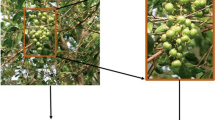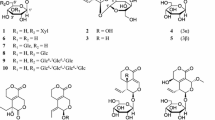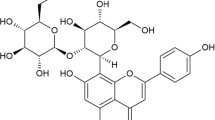Abstract
The leaves of Myrica rubra sieb. et zucc. have been used in oriental traditional medicine for the treatment of burns, skin diseases, and as an antidiarrheal in China, Japan, and Korea. Activity guided isolation of the leaves of M. rubra has led to the isolation of five flavonoid: myricetin (1), myricitrin (2), myricetin 3-O-(2″-O-galloyl)-α-L-rhamnopyranoside (3), myricetin 3-O-(2″-O-galloyl)-β-D-galactopyranoside (4), and quercetin 3-O-(2″-O-galloyl)-β-D-galactopyranoside (5). All isolates were evaluated for their antioxidant potency against the superoxide anion (O2 −), and compounds 3–5 showed potent scavenging activities with 50 % inhibition concentration (IC50) values compared to the positive control, allopurinol. Compounds 1–5 were evaluated as inhibitors of various macrophage functions involved in the inflammatory process. These five compounds significantly and dose dependently inhibited lipopolysaccharide (LPS)-stimulated nitric oxide (NO), pro-inflammatory cytokines, and the protein levels of inducible nitric oxide synthase (iNOS) and cyclooxygenase-2 (COX-2) in LPS-stimulated RAW 264.7 macrophages. Our results suggest that galloyl flavonol glycosides (3–5) isolated from M. rubra might be beneficial for the treatment of inflammation‐related diseases.




Similar content being viewed by others
References
Cheng, H.Y., T.C. Lin, K. Ishimaru, C.M. Yang, K.C. Wang, and C.C. Lin. 2003. In vitro antiviral activity of prodelphinidin B-2 3,3′-Di-O-gallate from Myrica rubra. Planta Medica 69: 953–956.
Coussens, L.M., and Z. Werb. 2002. Inflammation and cancer. Nature 420: 860–867.
D’Acquisto, F., M.J. May, and S. Ghosh. 2002. Inhibition of nuclear factor kappa B (NF-κB): an emerging theme in anti-inflammatory therapies. Molecular Interventions 2: 22–35.
Dalgleish, A.G., and K.J. O’Byrne. 2002. Chronic immune activation and inflammation in the pathogenesis of AIDS and cancer. Advances in Cancer Research 84: 231–276.
Forstermann, U., H.H. Schmidt, J.S. Pollock, H. Sheng, J.A. Mitchell, T.D. Warner, M. Nakane, and F. Murad. 1991. Isoforms of nitric oxide synthase: characterization and purification from different cell types. Biochemical Pharmacology 42: 1849–1857.
Hensley, K., K.A. Robinson, S.P. Gabbita, S. Salsman, and R.A. Floyd. 2000. Reactive oxygen species, cell signaling, and cell injury. Free Radical Biology and Medicine 28: 1456–1462.
Inoue, T., Y. Aral, and M. Nagai. 1984. Diarylheptanoids in the bark of Myrica rubra sieb. et zucc. Yakugaku Zasshi 104: 37–41.
Kim, Y.I., S.H. Lee, and T.S. Cho. 1996. Isolation of anticancer agents from the leaves of Platycarya strobilacea S. et Z. Korean Journal of Pharmacognosy 27: 238–245.
Kubes, P., and D.M. McCafferty. 2000. Nitric oxide and intestinal inflammation. American Journal of Medicine 109: 150–158.
Lee, T.H., F. Qiu, G.R. Waller, and C.H. Chou. 2000. Three new flavonol galloyl glycosides from leaves of Acacia confusa. Journal of Natural Products 63: 710–712.
Lu, Y., and L.M. Wahl. 2005. Oxidative stress augments the production of matrix metalloproteinase-1, cyclooxygenase-2, and prostaglandin E2 through enhancement of NF-κB activity in lipopolysaccharide-activated human primary monocytes. The Journal of Immunology 175: 5423–5429.
Martínez-Cayuela, M. 1995. Oxygen free radicals and human disease. Biochimie 77: 147–161.
Masuda, T., T. Someya, and A. Fujimoto. 2010. Phenolic inhibitors of chemical and enzymatic oxidation in the leaves of Myrica rubra. Bioscience, Biotechnology, and Biochemistry 74: 212–215.
Matsuda, H., M. Higashino, W. Chen, H. Tosa, M. Iinuma, and M. Kubo. 1995. Studies of cuticle drugs from natural sources. III. Inhibitory effect of Myrica rubra on melanin biosynthesis. Biological &/and Pharmaceutical Bulletin 18: 1148–1150.
Matsuda, H., T. Morikawa, J. Tao, K. Ueda, and M. Yoshikawa. 2002. Bioactive constituents of Chinese natural medicines. VII.1 Inhibitors of degranulation in RBL-2H3 cells and absolute stereo structures of three new diarylheptanoid glycosides from the bark of Myrica rubra. Biological &/and Pharmaceutical Bulletin 50: 208–215.
Nonaka, G., M. Muta, and I. Nishioka. 1983. Myricatin, a galloyl flavanonol sulfate and prodelphinidin gallates from Myrica rubra. Phytochemistry 22: 237–241.
Peri, K.G., P. Hardy, D.Y. Li, D.R. Varma, and S. Chemtob. 1995. Prostaglandin G/H synthase-2 is a major contributor of brain prostaglandins in the newborn. Journal of Biological Chemistry 270: 24615–24620.
Sakurai, N., Y. Yaguchi, and T. Inoue. 1986. Triterpenoids from Myrica rubra. Phytochemistry 26: 217–219.
Smith, W.L., and R. Langenbach. 2001. Why there are two cyclooxygenase isozymes. The Journal of Clinical Investigation 107: 1491–1495.
Surh, Y.J., and H.K. Na. 2008. NF-κB and Nrf2 as prime molecular targets for chemoprevention and cytoprotection with anti-inflammatory and antioxidant phytochemicals. Genes and Nutrition 2: 313–317.
Thun, M.J., S.J. Henley, and T. Gansler. 2004. Inflammation and cancer: an epidemiological perspective. Novartis Foundation Symposium 256: 6–21.
Wang, S.J., Y. Tong, S. Lu, R. Yang, X. Liao, Y.F. Xu, and X. Li. 2010. Anti-inflammatory activity of myricetin isolated from Myrica rubra sieb. et zucc. Leaves. Planta Medica 76: 1492–1496.
Acknowledgments
This research was supported by Basic Science Research Program through the National Research Foundation of Korea (NRF) funded by the Ministry of Education, Science, and Technology (2010-0022929).
Author information
Authors and Affiliations
Corresponding author
Additional information
Han Hyuk Kim and Dong Hee Kim contributed equally to this study.
Rights and permissions
About this article
Cite this article
Kim, H.H., Kim, D.H., Kim, M.H. et al. Flavonoid constituents in the leaves of Myrica rubra sieb. et zucc. with anti-inflammatory activity. Arch. Pharm. Res. 36, 1533–1540 (2013). https://doi.org/10.1007/s12272-013-0147-x
Received:
Accepted:
Published:
Issue Date:
DOI: https://doi.org/10.1007/s12272-013-0147-x




